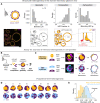This is a preprint.
Configurational entropy is an intrinsic driver of tissue structural heterogeneity
- PMID: 37425903
- PMCID: PMC10327153
- DOI: 10.1101/2023.07.01.546933
Configurational entropy is an intrinsic driver of tissue structural heterogeneity
Abstract
Tissues comprise ordered arrangements of cells that can be surprisingly disordered in their details. How the properties of single cells and their microenvironment contribute to the balance between order and disorder at the tissue-scale remains poorly understood. Here, we address this question using the self-organization of human mammary organoids as a model. We find that organoids behave like a dynamic structural ensemble at the steady state. We apply a maximum entropy formalism to derive the ensemble distribution from three measurable parameters - the degeneracy of structural states, interfacial energy, and tissue activity (the energy associated with positional fluctuations). We link these parameters with the molecular and microenvironmental factors that control them to precisely engineer the ensemble across multiple conditions. Our analysis reveals that the entropy associated with structural degeneracy sets a theoretical limit to tissue order and provides new insight for tissue engineering, development, and our understanding of disease progression.
Keywords: Cell fluctuations; Cell sorting; Entropy; Heterogeneity; Interfacial mechanics; Mammary organoids; Statistical mechanics; Tissue self-organization.
Conflict of interest statement
DECLARATION OF INTERESTS Z.J.G. is an equity holder in Scribe biosciences, Provenance Bio, and Serotiny.
Figures






Similar articles
-
A strategy for tissue self-organization that is robust to cellular heterogeneity and plasticity.Proc Natl Acad Sci U S A. 2015 Feb 17;112(7):2287-92. doi: 10.1073/pnas.1410776112. Epub 2015 Jan 29. Proc Natl Acad Sci U S A. 2015. PMID: 25633040 Free PMC article.
-
Tailoring Interfacial Nanoparticle Organization through Entropy.Acc Chem Res. 2018 Apr 17;51(4):900-909. doi: 10.1021/acs.accounts.8b00001. Epub 2018 Mar 28. Acc Chem Res. 2018. PMID: 29589915 Review.
-
Configurational entropy of hydrogen-disordered ice polymorphs.J Chem Phys. 2014 Jun 21;140(23):234502. doi: 10.1063/1.4882650. J Chem Phys. 2014. PMID: 24952547
-
Configurational Entropy of Folded Proteins and Its Importance for Intrinsically Disordered Proteins.Int J Mol Sci. 2021 Mar 26;22(7):3420. doi: 10.3390/ijms22073420. Int J Mol Sci. 2021. PMID: 33810353 Free PMC article.
-
Computer Simulations of Intrinsically Disordered Proteins.Annu Rev Phys Chem. 2017 May 5;68:117-134. doi: 10.1146/annurev-physchem-052516-050843. Epub 2017 Feb 6. Annu Rev Phys Chem. 2017. PMID: 28226222 Review.
References
Publication types
Grants and funding
LinkOut - more resources
Full Text Sources
